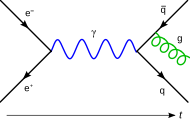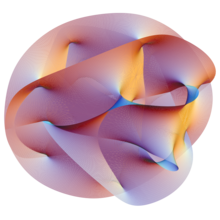正弦-戈尔登方程

正弦-戈尔登方程是十九世纪发现的一种偏微分方程:
来自下面的拉量:
由于正弦-戈尔登方程有多种孤立子解而倍受瞩目。
孤立子解
扭型孤立子
 |
 |
钟型孤立子
正弦-戈尔登方程有如下孤立子解:
其中
 |
 |
双孤立子解
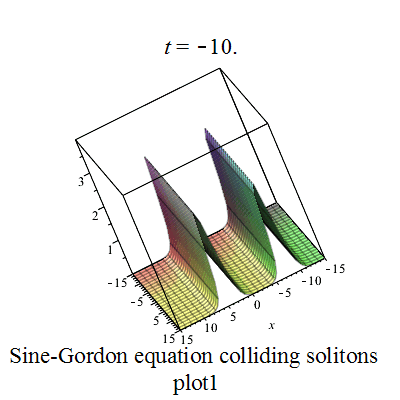 |
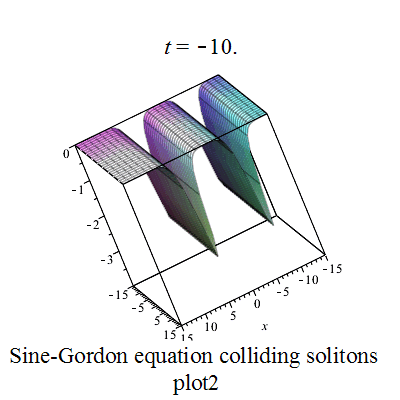 |
 |
 |
 |
 |
 |
  |
三孤立子解
 |
 |
呼吸子解

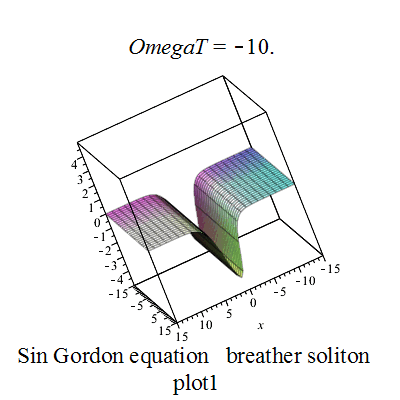 |
 |
几何解释
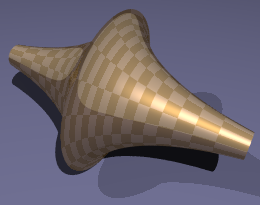
根据陈省身的研究,正弦-戈尔登方程有一个几何解释:三维欧几里德空间的负常曲率曲面(伪球面)。[3]
正弦-戈尔登方程是:[4]
跟户田场论有关。[5]
量子场论
正弦-戈尔登是Thirring模特的S对偶。
半经典量子化:[6]
参见
参考文献
- ^ Rajaraman, R. Solitons and instantons : an introduction to solitons and instantons in quantum field theory. Amsterdam https://www.worldcat.org/oclc/17480018. (1987 [printing]). ISBN 0-444-87047-4. OCLC 17480018. 缺少或
|title=为空 (帮助) - ^ Inna Shingareva Carlos Lizarraga Celaya, Solving Nonlinear Partial Differential Equations with Maple and Mathematica, p86-94,Springer
- ^ 陈省身 Geometrical interpretation of the sinh-Gordon equation。annals Polonici Mathematici XXXIX 1981
- ^ Poli︠a︡nin, A. D. (Andreĭ Dmitrievich). Handbook of nonlinear partial differential equations. 2nd ed. Boca Raton, FL: CRC Press https://www.worldcat.org/oclc/751520047. 2012. ISBN 978-1-4200-8723-9. OCLC 751520047. 缺少或
|title=为空 (帮助) - ^ Xie, Yuanxi; Tang, Jiashi. A unified method for solving sinh-Gordon-type equations. Il Nuovo Cimento B. 2006-05-10, 121 (2): 115–120. ISSN 0369-3554. doi:10.1393/ncb/i2005-10164-6.
- ^ Faddeev, L.D.; Korepin, V.E. Quantum theory of solitons. Physics Reports. 1978-06, 42 (1): 1–87 [2020-02-03]. doi:10.1016/0370-1573(78)90058-3. (原始内容存档于2021-03-08) (英语).
阅读
- Bour E (1862). "Théorie de la déformation des surfaces" (页面存档备份,存于互联网档案馆). J. Ecole Imperiale Polytechnique. 19: 1–48.
- Rajaraman, R. (1989). Solitons and Instantons: An Introduction to Solitons and Instantons in Quantum Field Theory. North-Holland Personal Library. 15. North-Holland. pp. 34–45. ISBN 978-0-444-87047-6.
- Polyanin, Andrei D.; Valentin F. Zaitsev (2004). Handbook of Nonlinear Partial Differential Equations. Chapman & Hall/CRC Press. pp. 470–492. ISBN 978-1-58488-355-5.
- Dodd, Roger K.; J. C. Eilbeck, J. D. Gibbon, H. C. Morris (1982). Solitons and Nonlinear Wave Equations. London: Academic Press. ISBN 978-0-12-219122-0.
- Georgiev DD, Papaioanou SN, Glazebrook JF (2004). "Neuronic system inside neurons: molecular biology and biophysics of neuronal microtubules". Biomedical Reviews 15: 67–75.
- Georgiev DD, Papaioanou SN, Glazebrook JF (2007). "Solitonic effects of the local electromagnetic field on neuronal microtubules". Neuroquantology 5 (3): 276–291.
| |||||||||||||||||||||||||||||||||||||||||||||||||||
| ||||||||||||||||||||||||||||||||||||||||||||||||||||||||||||
Text is available under the CC BY-SA 4.0 license; additional terms may apply.
Images, videos and audio are available under their respective licenses.












